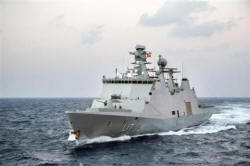 |
|


Watchdog
body urges Syria to speed up chemical handover
[January 08, 2014] AMSTERDAM (Reuters) — The world's chemical weapons watchdog, which is overseeing the destruction of Syria's toxic arsenal, called on the government of President Bashar al-Assad to pick up momentum in handing over the remaining chemicals.
|
Syria missed a deadline to transport the most toxic
substances out of the country by December 31, loading a first
batch of chemicals onto a Danish cargo vessel on Tuesday, a week
late. The Syrian government has until the end of March to hand over
the so-called first priority chemicals, including around 20
tonnes (1 tonne= 1.102 metric tons) of lethal mustard gas, and
to the end of June to completely eliminate its chemical weapons
program. "We are exhorting the Syrian government to intensify its
efforts, so we can conclude the critical part of this mission
absolutely as fast as the conditions allow," Michael Luhan,
spokesman for the Organisation for the Prohibition of Chemical
Weapons, said on Wednesday. "We are happy to see there is finally movement. We hope to see
that that movement continues regularly now through the next few
weeks, so we can get these chemicals out of the country as
quickly as possible." Syria declared 1,300 tonnes of chemical weapons to the OPCW,
which won the Nobel Peace prize last year, and is transporting
them by road to the port of Latakia so they can be destroyed
abroad. Chemical weapons were likely used in five out of seven attacks
investigated by U.N. experts in Syria, where a nearly
three-year-old year civil war has killed more than 100,000
people, a U.N. investigation found. The most serious attack was on August 21, when hundreds of
people died in a sarin gas strike in the outskirts of the
capital, Damascus. That attack prompted the United States to threaten to use
military force against Assad's regime, which it said was likely
responsible. The bulk of the chemicals will be processed on the Cape Ray, a
200-meter (650-foot) U.S. cargo ship, which is being fitted with
a portable hydrolysis system to neutralize around 560 tonnes of
the most deadly toxins. The remainder will go to commercial toxic waste processing
plants, including one in England. (Reporting by Anthony Deutsch; editing by Giles Elgood) [© 2014 Thomson Reuters. All rights reserved.] Copyright 2014 Reuters. All rights reserved. This material may not be published,
broadcast, rewritten or redistributed.
|


